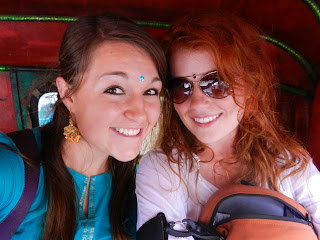 |
| Sarah and I sporting our beautiful decorative bindis in an auto rickshaw! |
Bindi, in Hindi, means "drop, small particle, or dot."
It is a common misconception that the Bindi is merely a religious symbol for Hindus as a symbol of wedlock. It can also mean other things - especially today in modern-day India. It is no longer affiliated with age, marital status, ethnicity, or class. In fact, the Bindi has generally become a symbol of culture in countries all over southeast Asia (Bangladesh, India, Bhutan, Nepal, Malaysia, Sri Lanka, etc.) And people of all religions wear bindis - like I said, it's more a matter of culture.
In India, women that are married generally do wear a dark red bindi (of any size) on their forehead between their eyebrows. Traditionally, when women cross the threshold of marriage, the red bindi is said to usher in prosperity. They often have a vermilion line of red paint that goes from their hairline at the top of the forehead back along the part of the hair. Some married women also use mehndi (henna) and dye their hair red.
The red represents honor, love, and prosperity.
Religiously, the bindi is symbolic to Hindus. It can be referred to as the "third eye." The placement between the eyebrows is known as the sixth chakra, ajna, or the seat of "concealed wisdom." It is known to be the exit point of the kundalini energy, or the "awakening" energy so the bindi is said to retain energy and strengthen concentration. It's location also corresponds to the pineal gland which has been regarded as the "seat of the soul."
Today, the bindi is often wore by women of all cultures, in all colors. However,they aren't as fashionable to the modern generations. In the 1990's, American celebrities popularized the bindi among American teens and some still wear them. You can buy adhesive bindis of all kinds. Some women, generally older, still use paint. Some put a small pinpoint-size dot, others a larger dot that covers merely the entire space between the eyebrows!
Oh and...men can wear them too (I've seen it!)! They're then usually called a tilak, kumkum, or again, a bindi.
I have various packages of bindis, and I love them! They aren't all dots, they aren't all red, and some even have rhinestones and sparkles! Welcome to India!

No comments:
Post a Comment